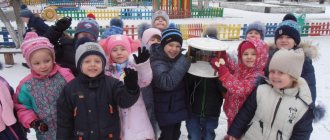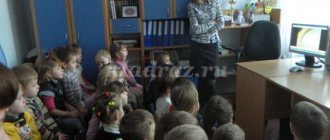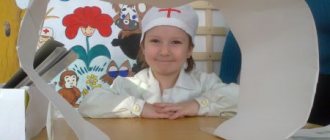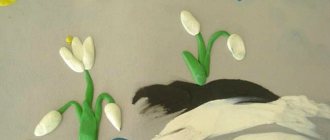Environmental project in the middle group “The world through the eyes of children”
author: Boldyreva Svetlana Aleksandrovna
Teacher, Samara MBDOU "Kindergarten 452 "Businka"
Environmental project in the middle group “The world through the eyes of children”
Environmental project in secondary group No. 4 “Chamomile” “The world through the eyes of children”
Educator: Boldyreva Svetlana Aleksandrovna MBDOU No. 452
PROJECT
on environmental education of middle group children
"The world of animals through the eyes of children"
Explanatory note.
The Year of Ecology has started across Russia. The problem of environmental education of preschool children is becoming particularly acute and relevant. It is during preschool childhood that the beginnings of ecological culture are formed. Therefore, it is very important to awaken in children an interest in living nature, to cultivate a love for it through knowledge of the world around them.
The role of animals in nature is so great that a person could hardly not only get along, but even simply live without them. And the point is not only that animals provide man with food, fur and wool, and serve him with their strength, speed and endurance. There is no doubt that the “Red Book”
Both nature reserves and national natural parks are very necessary for the protection of wildlife. But even more important is the responsibility for nature that every person bears.
Students from our group also actively participated in environmental events. We invited the families of our pupils to participate in the project “The World of Animals through the Eyes of Children”.
The project will take place in 4 stages:
- “Animals through the eyes of children” (drawings of animals of the Krasnodar region)
; - Exhibition on the theme “Animal diversity” (crafts and needlework)
; - “Sea inhabitants” (drawings of the inhabitants of the Black Sea)
; - Tabletop mini-presentations “My Pet” (photo collages, folding albums about pets)
.
Children can display their desire to protect nature in their creative works.
The best works will take part in the design of a kindergarten gift calendar.
Project goal: to create conditions for the development of children’s cognitive and creative abilities in the process of developing a child-adult educational project “The Animal World through the Eyes of Children”
in pupils of middle preschool age.
In accordance with the goal, the following project objectives were formulated:
- Enriching and deepening children's understanding of the animals of their native land, their diversity and living conditions.
- To develop knowledge about the interconnection of all living things in nature, to promote awareness of the special relationship of people to animals and to nature in general.
- Analyze educational and methodological literature on environmental education of middle-aged children;
- Enrich and consolidate the knowledge and ideas of preschoolers about animals living in our forests.
- Teach children to have a kind attitude towards animals.
- Supplement didactic material on environmental education of middle-aged children;
- Develop a system of games that ensure the consistent development of children in the context of play activities;
- Develop information sheets for parents with recommendations for familiarization with this topic.
- Enrich children's vocabulary with names of signs and actions by designating qualities (features of appearance, nutrition, habits)
. - Introduce children to the concept of “Red Book”
. - To develop children's coherent speech through writing a descriptive story about animals and retelling a literary text.
The novelty of the project will be the use of information and communication technologies that help improve the quality, accessibility and effectiveness of environmental education for children. This will make it possible to form elements of logical thinking and develop the intellectual abilities of children, without violating the laws and stages of mental and physiological development, and also taking into account the individual characteristics of children, which makes teaching children interesting, meaningful, and unobtrusive.
Implementation period: long-term, January 2022. – August 2022
Type of project: educational - gaming.
Project participants: middle school students, parents, teacher.
By number of participants: collective.
Form of organization of children: group, subgroup and individual.
Basic principles of project implementation:
— Accessibility (correspondence of the didactic task to the age and individual capabilities of children);
— Repeatability (consolidating and complicating the same game)
;
— The relevance of didactic material (up-to-date formulations of environmental problems, visual aids, etc.) actually helps children perceive tasks as a game, feel interested in getting the right result, and strive for the best possible solution;
— Collectivity (allows you to unite the children's team into a single group, into a single organism capable of solving problems of a higher level than those available to one child, and often more complex);
— Competitiveness (creates in a child or a subgroup the desire to complete a task faster and better than competitors, which allows reducing the time to complete the task on the one hand, and achieving a truly acceptable result on the other);
— An element of novelty (the introduction of new attributes, schemes, samples, the possibility of creativity, changing the rules).
Working hypothesis - it is assumed that organized work on environmental education of preschool children in accordance with modern requirements will help to increase the level of development of children's cognitive abilities.
Project implementation stages:
- Preparatory.
At this stage the following activities were carried out:
Studying the level of knowledge on the topic;
Monitoring diagnostics of children;
Drawing up a work plan for project implementation;
Creation of a subject-developing environment on the topic of the project;
Selection of teaching materials, illustrations, photographs, poems, presentations, didactic games, audio and video recordings on this topic;
Preparation of consultations, messages and teaching aids for parents;
Interaction with parents:
- Joint production of didactic games “Where is whose house?”
,
“Whose baby?”
and etc. ; - Assistance in the creation and design of an exhibition on the topic: “Diversity of animals” (crafts and needlework)
; - Tabletop mini-presentations “My Pet” (photo collages, folding albums about pets)
.
Analysis and generalization of existing work experience on this topic in preschool educational institutions;
Studying the experience of other educational institutions.
- Basic.
At this stage, practical work is carried out in order to obtain a high-quality result of this project. Namely:
Conversations with children, solving riddles;
Examination of illustrations, postcards, books on the topic;
View presentations on the topic;
Familiarity with objects in the immediate environment;
Reading fiction and memorizing rhymes;
Children reading poems;
Conducting didactic, plot-role-playing, movement, tabletop and finger games;
Theatrical activities;
Exhibitions of children's drawings “Animals through the eyes of children”
and
"Sea Life"
;
Dramatization “How the animals became friends”
;
Consultations for parents on the topic: “Environmental education of middle-aged children”
.
Creative and productive activities: modeling, drawing, appliqué (joint work of children with parents, independent activity of children;
Watching animated films about animals.
Listening to music.
Business game with parents: “How to understand the world of ecology?”
. Conducting consultations, developing recommendations and manuals for parents.
- Final.
- Positive dynamics of monitoring on environmental education of children of middle preschool age;
- Exhibition of joint creativity between children and parents;
- Creation of a gift calendar “The world of animals through the eyes of children”
, together with parents.
Expected result:
The project will contribute to the development of children’s cognitive and creative abilities, clarify and consolidate ideas about wild animals, habitats and food. The various situations and games used in this project will generate interest, curiosity, and attention in students.
Parents will receive methodological recommendations on creating conditions for conducting didactic games, advice on purchasing and making didactic games, since with the help of games and manuals, preschool children will unnoticed enter the world of ecology. Exciting games will help make the educational process not difficult or boring, but interesting and entertaining!
By implementing this project, we will try to help each child expand their horizons in their immediate environment, as well as create conditions for the development of independent cognitive activity. This project will provide each child with the opportunity not only to gain knowledge, but also to develop creative abilities, develop communication skills, and form the initial prerequisites for research activities. In turn, parents will develop an interest in the educational process, the development of creativity, knowledge and skills in children, a desire to communicate with teachers, and participate in the life of the group.
Bibliography:
- FROM BIRTH TO SCHOOL. Approximate basic general education program for preschool education / Ed. N. E. Veraksy, T. S. Komarova, M. A. Vasilyeva. – 3rd ed., rev. And additional – M.: MOSAIKA – SYNTHESIS, 2012;
- Federal State Educational Standards for Preliminary Education: implementation practice. – M.: Publishing house “Teacher”
, 2014. - Bashaeva T.V. Development of perception in children. Shape, color, sound. — Yaroslavl: Development Academy, 2007;
- Dybina O. V. The child and the world around him. Program and methodological recommendations. – M.: MOSAIKA – SYNTHESIS, 2010;
- Evdokimova E. S. Pedagogical support for families in raising a preschooler. – M.: TC Sfera, 2008.
- Lykova I. A. Visual activities in kindergarten. Middle group. – M.: “Color World”
, 2012. - Mikhalevskaya I. A., Masterkova E. A. A large reader for preschoolers. – M.: My World, 2008.
- Oberemok S. M. Project method in preschool education: Educational manual. – Novosibirsk: NIPKiPRO, 2007.
- Solomennikova O. A. Environmental education in kindergarten. Program and methodological recommendations. – 3rd ed., rev. and additional – M.: MOSAIKA – SYNTHESIS, 2009;
- Pilyugina V. A. Baby’s sensory abilities: Games to develop the perception of color, shape, size in young children. – M.: enlightenment. JSC "Ucheb.
met" 1996; - Collection of Russian folk tales. Ed. R. Kobzareva. – M.: Publishing house “Altey”
, 2012. - Soboleva A.V., Riddles - savvy. Practical guide for speech therapists, educators and parents - M.: “Publishing house GNOM and D”, 2000
Environmental project in the middle group “The world through the eyes of children”
Environmental education of middle preschool children
Elena Tsebenko
Environmental education of middle preschool children
Environmental education of middle preschool children.
Tsebenko Elena Ivanovna MKDOU d. from 401 Novosibirsk
Environmental education of middle preschool children
Nowadays, the problem of environmental education has come to the fore and is receiving more and more attention.
Why has this problem become relevant? The reason is human activity in nature, often illiterate and incorrect from an environmental point of view , wasteful, leading to a disruption of the ecological balance .
Each of those who brought and are causing harm to nature was once a child. of preschool institutions in the environmental education of children , starting from an early age , is so great .
Our task is to show parents the need to instill an environmental culture in their children .
“ ecological culture ” include?
?
Ecological culture is knowledge, practical skills, aesthetic experiences, emotional attitude and practical actions and behavior of children (empathy, sympathy, interest and desire to help nature, the ability to admire its beauty, etc.)
The main task of getting to know the environment in a preschool educational institution is to form in children a holistic perception and understanding of various objects and phenomena of the surrounding reality.
Classes to familiarize yourself with the environment include familiarization with the phenomena of social life; familiarization with the objective world created by man; familiarization with the phenomena of living and inanimate nature.
During classes, children to a certain type of properties, connections and relationships, specific to each of the four main areas of pedagogical work highlighted in the program: “Human”
,
“Objective world”
,
“Living nature”
,
“Inanimate nature”
.
Preschool childhood is the initial stage of personality formation and its value orientation in the world around us. At this age , the child develops a positive attitude towards nature, himself and the people around him.
Fostering a caring attitude towards the natural environment in middle-aged children begins in the family and continues to develop in the preschool years in kindergarten .
The goal of environmental education is the formation of a new type of person with new ecological thinking , capable of realizing the consequences of their actions in relation to the environment and able to live in relative harmony with nature.
Elementary environmental knowledge acquired by children at a young age environmental subjects ; it is necessary to form an environmental culture of preschoolers in kindergarten from the moment children in the first junior group.
Despite the visual-figurative nature of the thinking of preschoolers , we consider it necessary to acquaint them not only with the visible and tangible connections and relationships that exist in nature, but also with the hidden causes of natural phenomena. It is important to give the child not only the joyful surprise of a naturalist, but also to introduce him to the inquisitive analysis of a naturalist.
The process of developing a consciously correct attitude towards nature is accompanied by certain forms of child behavior, which can serve as a criterion for assessing the level of his environmental education . These are independent observations, experiments, questions, the desire to talk about experiences and impressions, to translate them into reality (reflect them in a game, in an art activity, care for animals and plants, etc.). (parents and teachers) should help them with this.
.
Children of middle preschool age have a very developed cognitive interest, in particular in nature. It is at this age that they perceive the world as a whole , which contributes to the formation of an ecological culture . It is very important to maintain this cognitive interest.
The content of the formation of the principles of environmental education should be scientific. It should contribute to the formation in children of a holistic perception of the world around them , on the one hand, and the interconnections of the parts of this whole, on the other.
, skills, and value relations in the field of environmental appropriate for preschool age in the family, kindergarten, through the media , observations, and reading fiction. The influence of the family on the formation of the beginnings ecological culture is determined by the attitude of its members to the surrounding nature and the general culture of the family members.
The formation of an ecological culture in a kindergarten involves the development of the child’s aesthetic and ethical feelings, which evoke joyful communication with nature, individual for each child, and have different emotional shades, positive or negative. With positive emotions, an awareness of the value of nature, its beauty, an aesthetic attitude towards it is formed, and the spiritual enrichment of the child’s personality occurs.
When organizing and conducting observations in nature in kindergarten, the following positions are important: the presence of natural objects; determining the content of observation; children in them .
Depending on the object and the age of the children, observations can be episodic, lasting several minutes (observation of a snowflake in the palm of your hand; observation of frost, the behavior of birds at the feeder; on a frosty day, listen to the creaking of snow; admire how the snow glistens in sunny weather; the melting of icicles; for a spring thunderstorm;) and long-term ones, which last for many days and sometimes weeks (for the behavior of fish in an aquarium; for snow; for the awakening and growth of plants; for buds on trees; for changes in the color of leaves; for a dandelion).
Long-term observations are valuable in that they allow us to capture the sequence in the occurrence of natural phenomena, their visible connection, which is accessible to the visual perception of a preschool child .
There is an opinion that in environmental education knowledge is not so important, and the main emphasis is on instilling a caring attitude towards nature and developing working skills in natural conditions. Of course, children’s emotional attitude towards natural objects , familiarity with a number of animals and plants, and caring for them play a big role in the formation of environmentally literate ideas about the environment . However, this is not enough: children need a minimum of environmental knowledge that will help them understand the need to behave environmentally competently . The combination of an emotional attitude towards nature and knowledge about it will give a much greater effect. It is necessary to combine the spiritual and intellectual development of the child wisely, taking into account the psychological and physiological characteristics. It should be noted that many teachers in the learning process draw children's , first of all, to living objects, especially animals. Very little attention is paid to objects of inanimate nature. At the same time, it is known that children a great interest in objects of inanimate nature, and with the correct organization of work (conducting experiments, observations)
The child easily acquires knowledge about inanimate nature and its connection with living nature.
Children should understand the reasons for the need to preserve all species of animals and plants without exception. They must be taught not to pick beautiful flowers, because these flowers can also disappear due to disturbance of their habitat. It is important that children understand the need to preserve all living organisms on Earth. The teacher should not use the words “harmful, useful”
.
Ecological knowledge becomes the basis of environmental education .
The child develops a certain system of values, an idea of man as a part of nature, of the dependence of his life and his health on its condition. It is also important to cultivate an understanding of the need for reasonable consumption. Environmental education is also associated with the development of a child’s emotions, the ability to sympathize, be surprised, empathize, take care of living organisms, perceive them as fellow creatures in nature, and be able to see the beauty of the world around them. The child should develop an active position, a desire to change something around him for the better. The teacher must make the children feel that even their feasible, seemingly insignificant, actions determine what the world around them will be like. The child must also understand his responsibility for the state of the environment . It is also important to involve children in practical activities: in the courtyard of the kindergarten and throughout the premises, at home, during excursions. children to communicate with nature during the formation of the principles of ecological culture can be satisfied by specially organized observation in kindergarten. Its essence lies in the sensory knowledge of natural objects, through various forms of perception - visual , auditory, tactile. Thus, I realized that children show great interest in natural objects and easily learn a variety of information if it attracts them. The main aspects of a teacher’s work with children are a variety of activities, an integrated approach to teaching, which contributes to the formation of not only an environmentally literate , but also a comprehensively developed person. teacher is one of the figures in the pedagogical process, including environmental education . Being a bearer of ecological culture , mastering the methods of environmental education , he organizes children’s activities so that they are meaningful, emotionally rich, contribute to the formation of practical skills and necessary ideas about nature, and gradually turn into independent behavior of children . The leading role in this process should be the joint activity of an adult and a child.
The main place in the system of environmental education should be given to activities through which all living things within the child’s field of vision develop normally (grow, give birth, bloom, etc.)
.
This activity is nothing more than the creation and maintenance of conditions for plants and animals located in various “ ecological spaces ” of the preschool institution .
Creating a stationary ecological and developmental environment in a kindergarten is a continuous pedagogical process, which includes the organization of group nature corners, a room or nature office, a greenhouse, etc., and the daily maintenance of conditions necessary for the full life of all living beings. Such constant activity teaches you to think and systematically and really take care of your “little brothers”
who share the same living space with children.
This activity becomes a method only if it is included in the pedagogical process and is performed together with adults and children. Teachers who do everything themselves and do not give preschoolers to observe and participate in creating normal conditions for the inhabitants of living corners develop in children indifference, callousness and inattention in general to life as a unique value. Joint organizational and economic activities, labor activities in the green area of the kindergarten, growing plants, caring for adults and animals and their offspring can take different forms and take place with varying degrees of participation, both adults and children . Preschoolers can become participants in this activity in three ways:
- by listening to the teacher’s about various activities and events in the preschool educational institution;
- observing the activities of adults;
- practically participating in it.
Whatever forms the joint activity of adults and preschoolers , the greatest importance in it is the teacher’s to the object of the activity, which is manifested in his interested story, emotional reactions, assessments, explanations and actions that are correct from an environmental point of view. An adult, by his behavior, creates a model of interaction with nature, a caring attitude towards it, demonstrates the necessity and significance of everything that happens in front of children . Joint activities can be carried out in any “ ecological space ”
indoors and on the site of the kindergarten. Its most common form is the creation and maintenance of the necessary conditions for the inhabitants of a group nature corner in a kindergarten.
Kindergarten is the first link in the system of continuous environmental education , so it is no coincidence that teachers are faced with the task of forming the foundations of a culture of rational environmental management among preschoolers .




